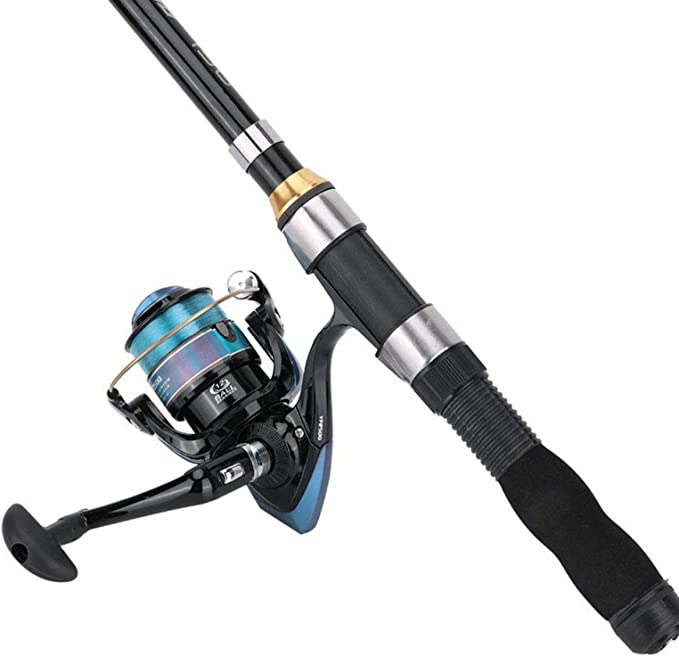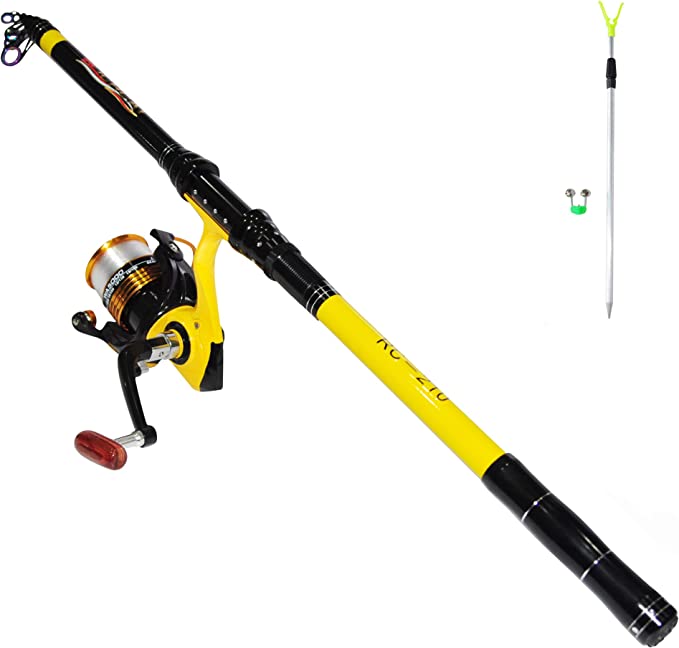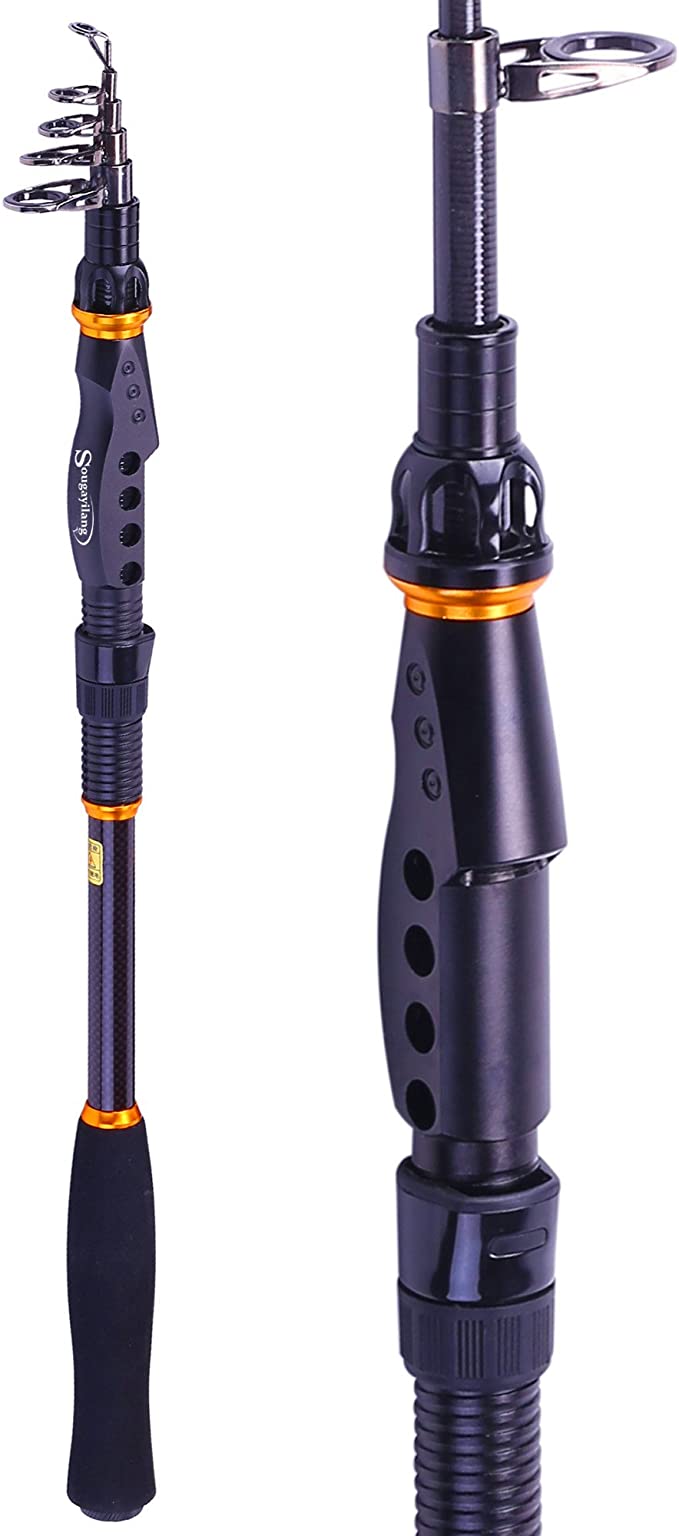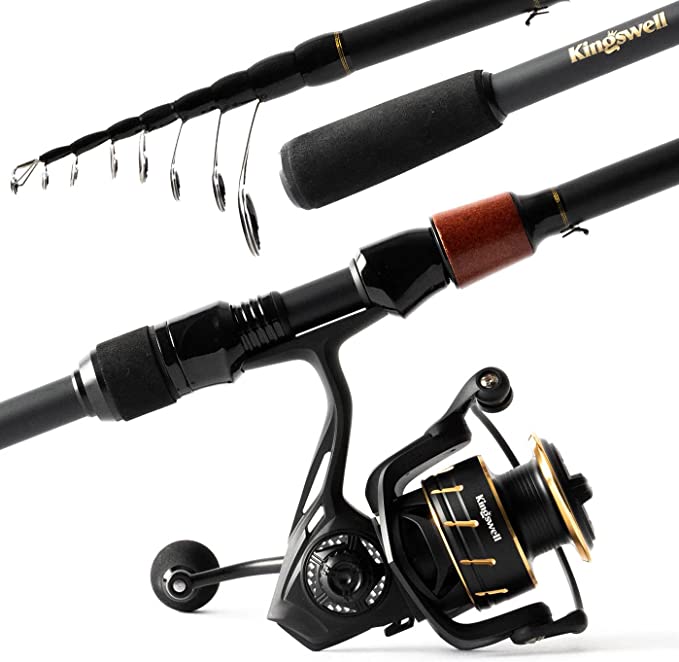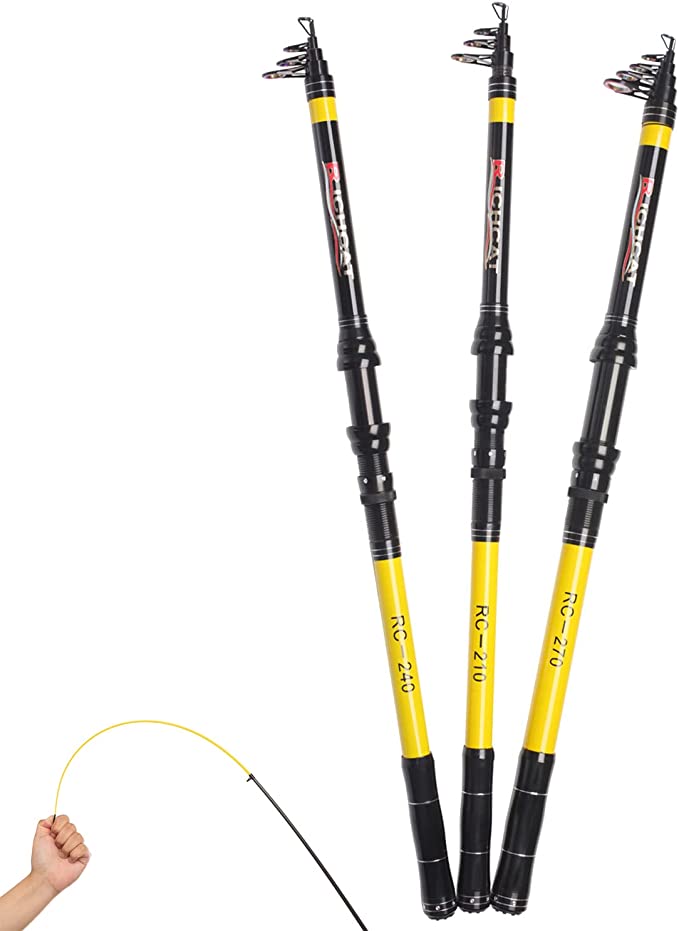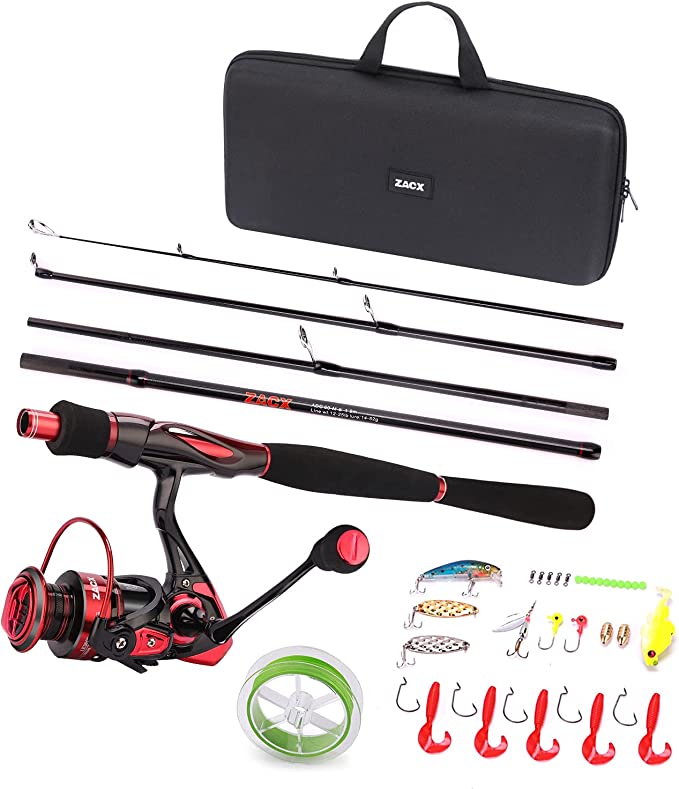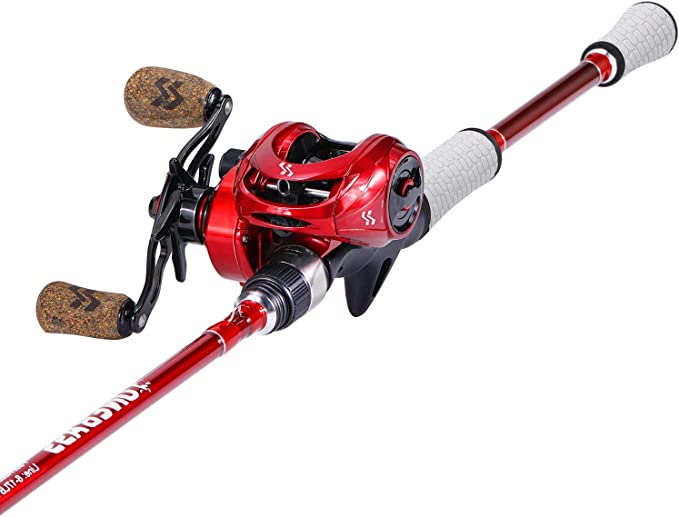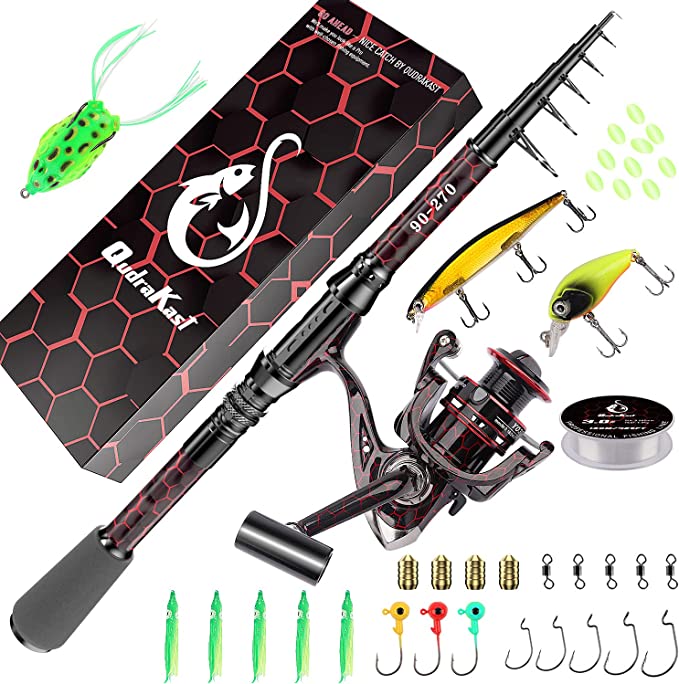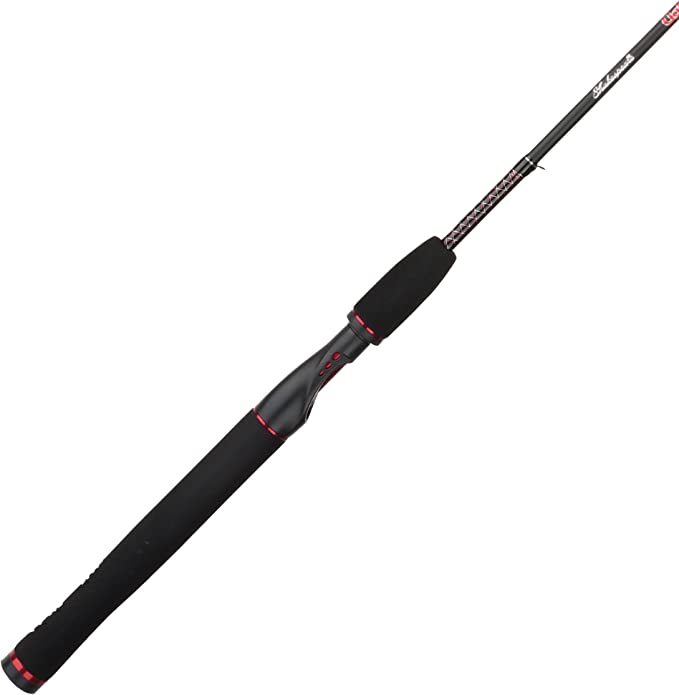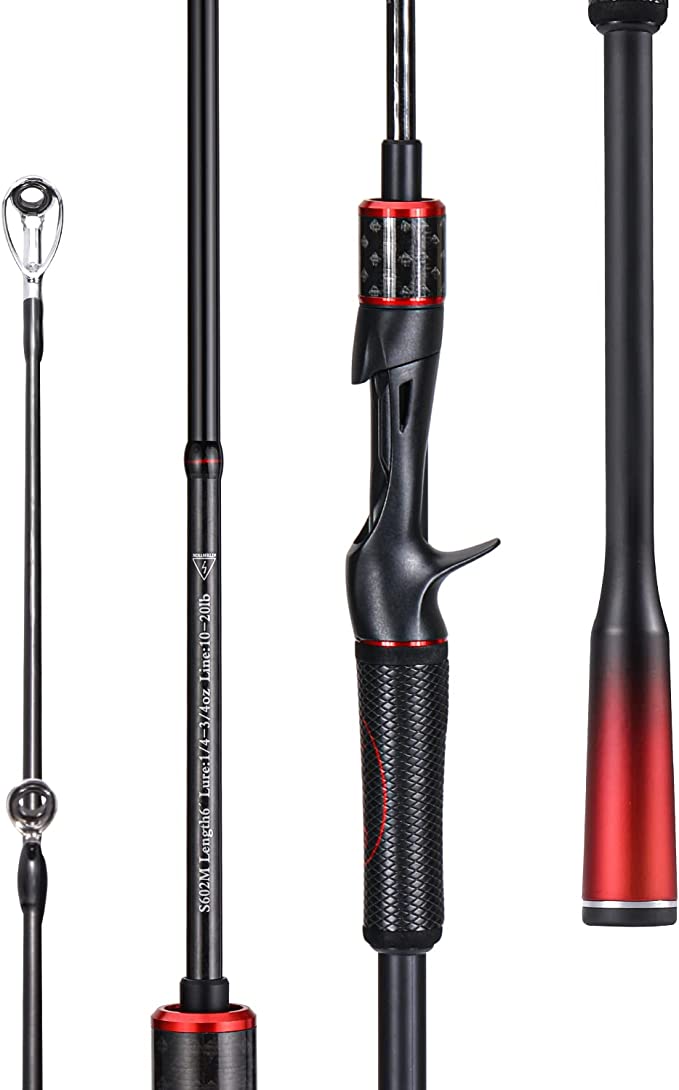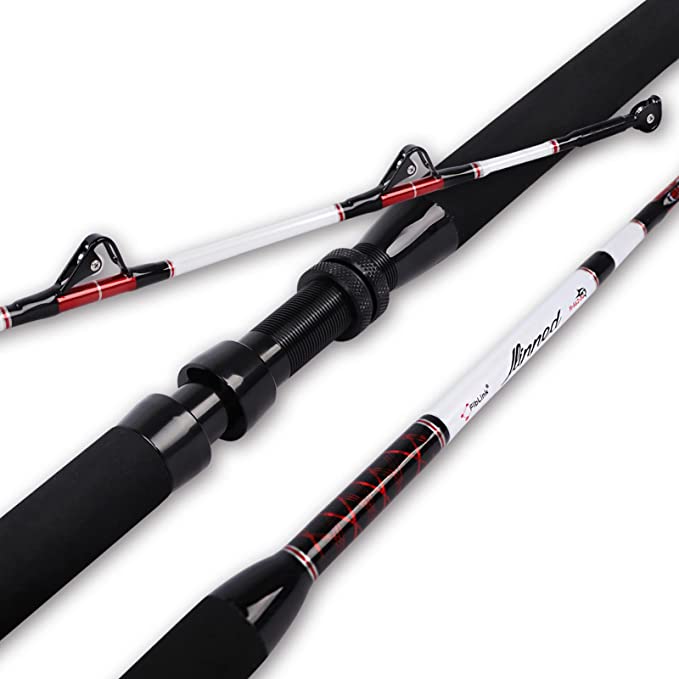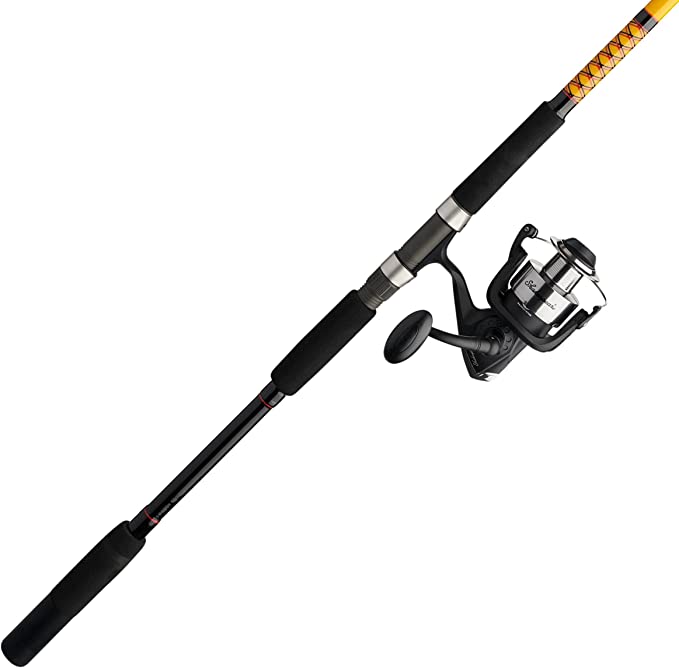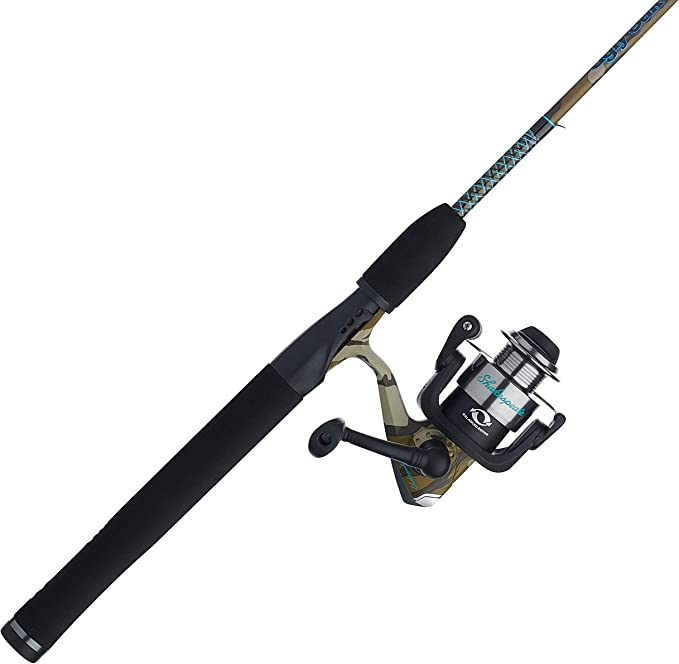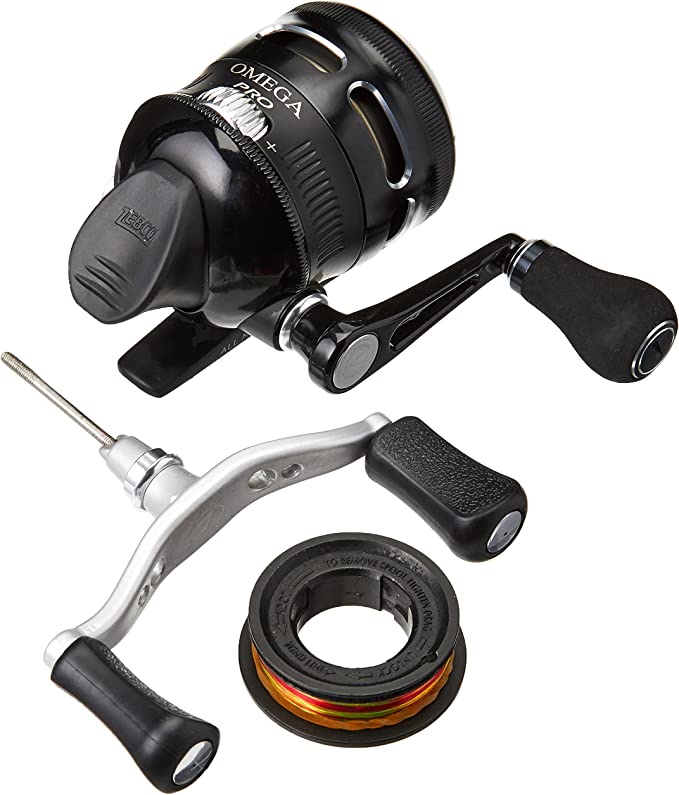The Daiwa Sweepfire Tele: A Comprehensive Analysis of the People's Travel Rod
Update on Aug. 6, 2025, 9:05 a.m.
For decades, the telescopic fishing rod has occupied a unique and often contentious space in the angling world. It represents a tantalizing promise: the freedom to have a capable fishing tool on hand for any spontaneous opportunity, collapsing down to a fraction of its working length to be stowed in a car boot, backpack, or piece of luggage. Yet, this promise has historically been shadowed by compromise. Anglers have long held the perception that telescopic designs are gimmicky, sacrificing the crisp action, sensitivity, and outright durability of their one or two-piece counterparts for the sake of convenience. The multiple joints, the sliding sections, and the often-inferior components were seen as inherent weak points, relegating them to the status of novelty items or tools for only the most casual of users.
Into this landscape steps the Daiwa Sweepfire Tele, an all-round telescopic spinning rod from one of the world’s most respected fishing tackle manufacturers. Daiwa’s reputation is built on decades of innovation and exacting Japanese quality standards, a pedigree that commands attention even at the budget end of the market. The Sweepfire Tele series is positioned by retailers and lauded by a legion of satisfied customers as the quintessential entry point into the sport. It is marketed as the ideal starter set for novice fishermen, a perfect first rod for children, and a go-to option for travelers seeking a convenient, easy-to-carry design. The central question, therefore, is a compelling one: Can a budget-friendly telescopic rod from a premier brand like Daiwa transcend the historical limitations of its design? This report seeks to answer that question through a meticulous deconstruction of the Sweepfire Tele. By synthesizing conflicting product specifications, analyzing a wealth of user testimony, and positioning the rod within the competitive market, this analysis will determine whether the Sweepfire Tele is a true Daiwa-quality product that delivers on the telescopic promise, or if it is simply a brand-licensed commodity built to a price point.

Deconstructing the Sweepfire: An Anatomical Review
A fishing rod is more than the sum of its parts, but a close examination of those parts is essential to understanding its intended purpose, performance envelope, and overall value. The Daiwa Sweepfire Tele, across its various iterations, presents a fascinating case study in component selection for the entry-level market, revealing both consistent quality in some areas and significant, often confusing, variations in others.
The Blank: The Heart of the Matter and a Point of Confusion
The blank is the core of any fishing rod, defining its action, weight, sensitivity, and strength. It is also the source of the single greatest point of confusion surrounding the Sweepfire Tele. An analysis of product descriptions from various global retailers reveals a startling lack of consistency in how the blank material is described. Different listings specify the material as a basic “Fibre blank” , a more performance-oriented “Carbon Blank” , a general “Composite blank” , and even “excellent Graphite material”.
This discrepancy is not merely a series of typos; it points to a fundamental aspect of the product’s market strategy. Each of these materials carries different connotations for an angler. A fibreglass or “fibre” blank is known for its exceptional durability and low cost, making it ideal for beginners and rough use, though it is typically heavier and less sensitive than its carbon counterpart. A carbon fibre or graphite blank is prized for its light weight, stiffness, and superior sensitivity, which allows an angler to feel subtle bites and the movement of a lure, but it is generally more brittle and expensive. A composite blank, as the name implies, is a blend of materials—typically fibreglass and carbon/graphite—designed to offer a balance of these properties.
The most authoritative source, Daiwa’s official German website, lists the blank as a “Composite”. This suggests that the Sweepfire Tele is not a single, rigidly defined product but rather a flexible, budget-oriented platform. Daiwa likely prioritizes hitting a specific, highly competitive price point. To achieve this, a composite blank is the logical choice, providing the durability needed for its target audience of novices and children while incorporating enough carbon to maintain a semblance of the lightweight feel and sensitivity associated with the Daiwa brand. Retailers may then simplify the term “composite” in their marketing copy, with some emphasizing the durability aspect by calling it “fibre” and others highlighting the performance element by calling it “carbon.” It is also plausible that different regional models or production runs under the broad Sweepfire Tele umbrella utilize slightly different blends in their composite, further contributing to the varied descriptions. This lack of precise material consistency is a hallmark of entry-level equipment, where achieving a balance of function and affordability takes precedence over adherence to high-performance, single-material specifications.

Hardware and Fittings: A Tale of Two Tiers
While the blank material is ambiguous, the hardware and fittings reveal a much clearer, and more telling, pattern. A careful analysis of the components across different models exposes what appears to be a deliberate two-tiered system within the Sweepfire Tele family.
The line guides are largely consistent, described as “Aluminium oxide ring guides” , occasionally noted as “Titanium oxide guides”. These are industry-standard components for budget-to-mid-range rods. They are smooth enough to handle modern braided lines without excessive wear and are housed in durable stainless steel frames, reinforcing the rod’s identity as a reliable, no-frills workhorse.
The critical divergence appears in the reel seat and handle. Product descriptions can be clearly sorted into two distinct groups.
- Group A, often referred to as the “Sweepfire Mini” range, is specified with a basic “Pipe reel seat” and a “Foam handle”. A pipe reel seat is a simple, functional, and very cost-effective component that clamps the reel foot down, common on the most affordable rods.
- Group B, often marketed as the “Sweepfire Telespin,” features a superior “DPS Reel Seat” and a more traditional “Cork Fore Grip and Handle” or “EVA handle”. The DPS reel seat is a well-known and trusted design from Fuji or similar manufacturers, offering a more secure and robust connection for the reel.
This is not a random variation; it is a clear pattern of component choice that defines two different product levels under the same family name. Consumers are not just selecting a length and casting weight; they are often unknowingly choosing between a lower-specification “Mini” version and a slightly better-appointed “Telespin” version. This distinction is crucial for managing expectations. An angler expecting the comfort of a cork handle and the security of a DPS reel seat could be disappointed if they receive a model with a foam grip and a basic pipe seat. This poorly communicated difference is a vital piece of information for any prospective buyer.
Action and Application
The rod’s action is described as a “Semi-progressive tip action”. This is a highly versatile and forgiving action, making it an excellent choice for the rod’s target audience. It means the rod is relatively soft and flexible in the tip section, which helps in casting lighter lures and provides good bite detection. As more pressure is applied, such as when fighting a fish, the power builds progressively through the middle and into the butt section of the rod. This prevents the rod from feeling overly stiff or “tippy,” which can lead to pulled hooks, especially for inexperienced anglers.
This all-round action supports the rod’s broad range of applications. Retailers and Daiwa’s own literature suggest it is suitable for nearly all common freshwater fishing styles, from spinning with lures for pike and perch to bait fishing for bream, carp, and even eels. This versatility is the cornerstone of its design, making it a true “all-round” tool for the angler who wants to be able to tackle a variety of situations with a single, convenient rod.
The Sweepfire Family: A Spectrum of Models
The Daiwa Sweepfire Tele is not a single rod but a sprawling family of models designed to cover a vast range of fishing scenarios. This breadth is one of its greatest strengths, but the sheer number of variations, coupled with the inconsistent specifications discussed previously, can be a source of confusion for consumers. The following table consolidates the available data to provide a clear, comparative overview of the product line, empowering the angler to select the right tool for their specific needs.
| Model SKU | Length (m) | Casting Weight (g) | Collapsed Length (cm) | Blank Material | Handle/Grip | Reel Seat | Price | Source(s) |
|---|---|---|---|---|---|---|---|---|
| Sweepfire Mini | Various | Various | Reduced | Fibre | Foam | Pipe | Unbeatable | |
| — | — | — | — | — | — | — | — | — |
| SW240TM-BU | 2.4 | 10-40 | Not Specified | Carbon | Cork | DPS | £42.99 | |
| — | — | — | — | — | — | — | — | — |
| SW270TMH-BU | 2.7 | 15-50 | Not Specified | Carbon | Cork | DPS | £46.99 | |
| — | — | — | — | — | — | — | — | — |
| SW300TH-BU | 3.0 | 20-60 | ~66 | Carbon | Cork | DPS | £49.99 | |
| — | — | — | — | — | — | — | — | — |
| 11420-210 | 2.1 | 5-20 | Not Specified | Not Specified | EVA | Titanium Oxide Guides | €26.44 | |
| — | — | — | — | — | — | — | — | — |
| 11420-240 | 2.4 | 10-40 | Not Specified | Not Specified | EVA | Titanium Oxide Guides | Not Specified | |
| — | — | — | — | — | — | — | — | — |
| 11420-360 | 3.6 | 5-35 | Not Specified | Not Specified | Not Specified | Not Specified | Not Specified | |
| — | — | — | — | — | — | — | — | — |
| SW40RPBF | 4.0 | Max 0.30 line | 123 | Not Specified | Not Specified | Not Specified | $50.90 | |
| — | — | — | — | — | — | — | — | — |
| SW50RPBF | 5.0 | Max 0.30 line | 127 | Not Specified | Not Specified | Not Specified | $67.90 | |
| — | — | — | — | — | — | — | — | — |
| SW60RPBF | 6.0 | Max 0.30 line | 131 | Not Specified | Not Specified | Not Specified | $90.99 | |
| — | — | — | — | — | — | — | — | — |
| Sweepfire Tele Spin | 9.84 ft (3.0) | 1.06-2.12 oz (30-60) | Not Specified | Not Specified | Not Specified | Not Specified | Not Specified | |
| — | — | — | — | — | — | — | — | — |
Use-Case Analysis
By analyzing the specifications across this range, we can categorize the models into distinct use-cases:
- Light Tackle & Travel: The shorter, lighter models, such as the 2.1m (5-20g) and 2.4m (10-40g) versions, are perfectly suited for the traveling angler and those who practice urban fishing. Their compact nature makes them ideal for carrying on a whim, and their casting weights are well-matched for targeting smaller species like perch, trout in small streams, and for fishing in confined spaces like canals, docks, and piers. One reviewer specifically highlighted the 2.1m model’s impressive performance in such urban settings.
- General Purpose & Novice Anglers: The 2.7m and 3.0m models represent the versatile workhorses of the Sweepfire family. These lengths offer a great balance of casting distance and control, making them the most popular choice for beginners, children, and anglers looking for a single rod to cover multiple situations. Their casting weights (e.g., 15-50g or 20-60g) provide enough power to handle a wide variety of lures and rigs, and they have proven capable of landing respectable fish, including pike and trout up to 3kg.
- Longer Range & Specialized Applications: The existence of longer models, including a 3.6m version (5-35g) and adjustable “Power” models extending up to an impressive 6.0m, demonstrates the platform’s adaptability. These longer rods are designed for more specialized techniques where casting distance is paramount, such as float fishing in rivers and lakes or light surfcasting from a beach. While less common in the available data, their presence shows the comprehensive nature of the Sweepfire Tele series, aiming to provide a low-cost telescopic option for nearly every conceivable style of shore-based angling.
The Voice of the Angler: A Synthesis of Customer Experiences
While technical specifications provide a blueprint, the true measure of a fishing rod is its performance in the hands of anglers. In this regard, the Daiwa Sweepfire Tele receives overwhelmingly positive feedback, with customer reviews painting a picture of a product that consistently punches above its weight class.
The Overwhelming Consensus: Unbeatable Value for Money
The most dominant theme emerging from user reviews is the rod’s exceptional value. Across multiple retail platforms, the Sweepfire Tele boasts near-perfect ratings, with one major retailer showing a score of 4.94 out of 5, based on 16 reviews where a staggering 94% of users awarded it a full 5 stars. This level of customer satisfaction is rare for any product, let alone one in the highly competitive budget fishing tackle category.
Anglers repeatedly use phrases that underscore this central appeal. It is described as offering “excellent quality and a first-class finish at an unbeatable price” and being a “really good rod for a super low price”. The sentiment of “very good value for money” is a constant refrain, establishing that consumers feel they are receiving a product whose quality and performance far exceed its modest cost. This powerful value proposition is the foundation of the rod’s popularity and success.
Performance in the Field: Exceeding Expectations
Beyond just price, users are genuinely impressed with the rod’s practical performance. It is frequently described as “strong and practical,” dispelling the notion that budget telescopic rods are inherently flimsy. The specific anecdote of the rod being “capable of handling a 3kg trout” provides a tangible and impressive benchmark for its power and reliability, giving prospective buyers confidence in its fish-fighting ability.
Its convenience is another major selling point. The telescopic design is praised for being “convenient and easy to carry,” making it the perfect companion for a “spontaneous session” when an unexpected fishing opportunity arises. This “grab-and-go” nature is a key part of its appeal. Furthermore, one user on a forum provided a detailed account of using the rod for smallmouth and largemouth bass in a challenging environment with a rocky bottom and numerous snags. They noted its surprising toughness, even using it to lift fish up a 5-foot wall onto a walkway—a testament to its real-world durability under stressful conditions.
Identified Shortcomings and Concerns
No product is perfect, and a balanced analysis requires acknowledging the few criticisms and concerns raised by users. While overwhelmingly positive, the feedback does highlight a few key issues.
One user reported a significant issue with logistics, stating their rod arrived “poorly packaged… in a plastic bag”. For a multi-sectioned rod with relatively delicate guide rings, this is a major concern and suggests that shipping protection may be inconsistent depending on the vendor.
More critically, the same user identified a significant design characteristic that challenges the rod’s primary selling point of portability. They noted, “it’s not a fully collapsible telescopic rod as expected the but[t] is 800-900 mm long”. This is a crucial piece of information. A non-collapsible butt section of 80-90 cm (approximately 31-35 inches) is substantial. Another user inquiry confirms this, with a retailer stating the collapsed length of a 3.0m model is approximately 26 inches (66cm). This reveals a “portability paradox.” While the rod is undeniably more convenient to transport than a one or two-piece rod of the same length, its long, fixed butt section makes it far less portable than a multi-piece travel rod that breaks down into shorter, uniform sections. This design makes the Sweepfire Tele an excellent choice for keeping in the boot of a car or for casual transport, but it is a significant drawback for anglers where every inch of pack space is critical, such as backpackers or those trying to fit their gear into standard airline luggage. This nuance re-contextualizes the rod’s convenience and is vital for managing the expectations of potential buyers.
Market Positioning: The Sweepfire in a Crowded Field
To fully appreciate the Daiwa Sweepfire Tele’s place in the angling world, it must be viewed not in isolation, but in the context of its competitors and its position within Daiwa’s own product hierarchy. This analysis reveals that the Sweepfire Tele occupies a well-defined niche, offering a unique blend of brand prestige and accessibility.
The Budget Champion vs. The Competition
The telescopic and budget rod market is fiercely competitive, but the Sweepfire Tele’s most direct rival, based on the available information, is the Shimano Spectrum Plus series. Like the Sweepfire, the Spectrum Plus is produced by a top-tier Japanese brand, is aimed squarely at beginners and budget-conscious anglers, and features a versatile, all-round design. The Spectrum Plus is consistently described as having a fibreglass blank with an integrated solid glass tip for sensitivity and durability, along with EVA grips and ceramic guides, making it a direct parallel in terms of materials and market position to the Sweepfire Tele. Both rods offer the consumer the confidence of a major brand name at an entry-level price point.
Framing the lower end of the market are brands like Jarvis Walker and Pioneer. Jarvis Walker offers extremely affordable telescopic combos, often bundled with tackle, making them a popular choice for absolute beginners and children. Pioneer also provides inexpensive “go anywhere” telescopic rods that prioritize cost above all else. While functional, these options generally lack the brand recognition and perceived component quality of the Daiwa and Shimano offerings. The Sweepfire Tele, therefore, positions itself slightly above these ultra-budget options, providing a tangible step up in quality and brand trust for a relatively small increase in price.
| Brand/Model | Price Range (AUD) | Key Features | Target Audience | Noted Strengths/Weaknesses | Source(s) |
|---|---|---|---|---|---|
| Daiwa Sweepfire Tele | ~$40 - $100+ | Composite/Carbon/Fibre Blank, Al-Oxide Guides, Cork/Foam Handle, DPS/Pipe Seat | Beginners, Kids, Travelers | Strengths: Excellent value, strong brand, good performance for price. Weaknesses: Inconsistent specs, long butt section. | |
| — | — | — | — | — | — |
| Shimano Spectrum Plus Tele | ~$45 - $75 | Fibreglass/Graphite Blank, Glass Tip, Ceramic Guides, EVA Grips | Beginners, Entry-Level | Strengths: Affordable, durable, good for beginners, solid fittings. Weaknesses: Basic materials. | |
| — | — | — | — | — | — |
| Jarvis Walker Combos | ~$40 | Fibreglass Blank, Spooled Reel, Tackle Kit Included | Absolute Beginners, Kids | Strengths: Extremely affordable, all-in-one kit. Weaknesses: Lower quality components, line often needs replacing. | |
| — | — | — | — | — | — |
| Pioneer Telescopic | ~$20 - $40 | Not Specified | Budget-conscious, Spontaneous Use | Strengths: Very inexpensive. Weaknesses: Basic construction, unknown long-term durability. | |
| — | — | — | — | — | — |
The Daiwa Hierarchy: Understanding the Trade-offs
The Sweepfire Tele sits at the base of Daiwa’s extensive travel and telescopic rod lineup. Understanding what an angler gains by spending more money helps to contextualize the Sweepfire’s value and its necessary compromises.
Moving up the ladder, Daiwa offers a range of more advanced multi-piece and telescopic travel rods. The Procyon Telescoping Travel Rod (MSRP $89.99) represents a step up in quality. Higher still are the
Ardito travel rods (MSRP $179.99+) and the highly regarded Wilderness series ($189.95+), which are multi-piece rods rather than telescopic. These models feature Daiwa’s more advanced blank technologies, such as
HVF (High Volume Fiber) Nanoplus, which creates a lighter, crisper, and more responsive blank.
At the premium end of the Japanese Domestic Market (JDM) offerings is the Daiwa Freegear series. These telescopic rods incorporate Daiwa’s proprietary
Braiding X carbon weave technology, which reinforces the blank to reduce twist and improve casting performance and fighting power. They are also equipped with higher-quality components like line-friendly
SiC (Silicon Carbide) guides and lightweight Air Sensor reel seats.
This comparison makes the Sweepfire’s position clear. It forgoes these advanced materials and technologies to achieve its accessible price point. An angler choosing the Sweepfire is trading the cutting-edge performance, sensitivity, and lighter weight of the Wilderness or Freegear for affordability and rugged simplicity. This is not a flaw, but a deliberate design choice that allows Daiwa to serve a different, much broader segment of the market. The Sweepfire provides the entry ticket to the Daiwa ecosystem, while models like the Freegear and Wilderness cater to the enthusiast who demands higher performance from a portable package.
The “Budefo” Anomaly and the Specter of Counterfeits
In the modern global marketplace, popular products from major brands are often targets for imitation and outright counterfeiting. The Daiwa Sweepfire is no exception, and the available information reveals a dual threat that consumers must navigate: direct counterfeits and “brand-alike” products designed to create confusion.
Analyzing the “Budefo Sweepfire”: A Case of Brand Mimicry?
A particularly interesting case is the “Budefo Sweepfire Rod” featured in a YouTube review. While the rod in the video is a 4-section travel rod, not a telescopic one, the use of the exact “Sweepfire” name is conspicuous. The brand “Budefo” appears frequently on online marketplaces like AliExpress, offering a range of budget-friendly fishing tackle, including travel rods that receive generally decent reviews for their price.
This situation highlights a subtle but potent issue. The Budefo Sweepfire may not be a direct counterfeit—a product illegally bearing the Daiwa logo. Instead, it appears to be a “brand-alike” or a “confusingly similar” product. This is a common tactic where a lesser-known manufacturer uses a well-known product name from a leading brand to draft off its established reputation and search engine visibility. An unsuspecting consumer searching for a “Daiwa Sweepfire” might easily purchase the “Budefo Sweepfire” by mistake, especially on a crowded online platform.
Daiwa’s Official Stance on Counterfeits
Daiwa is acutely aware of this problem. The company’s official US website features a stark and explicit warning: “BEWARE OF FRAUDULENT ADS AND FAKE PRODUCT WEBSITE SCAMS”. The statement makes it clear that Daiwa “does not have the ability to control the fraudulent ads or counterfeit products on the marketplace” and unequivocally states that the company “will not be liable for any reimbursement or replacement of these counterfeit products”. This firm stance underscores the prevalence and seriousness of the issue.
The problem is not limited to imitation products. There are discussions in online forums and videos that point to the existence of direct fakes—products that illegally use the Daiwa name and logo but are of inferior quality. These are often sold through third-party sellers on large e-commerce sites or via deceptive standalone websites that mimic official outlets. This is a significant risk for consumers, as these products will not perform to Daiwa’s standards and will not be covered by any warranty. The Australian Border Force reinforces the seriousness of this issue, as it explicitly lists fake (counterfeit) brand-name goods as prohibited imports, subject to seizure and penalties.
This situation requires a two-pronged approach to consumer protection. Firstly, to avoid outright counterfeit products, the most effective strategy is to purchase only from authorized Daiwa dealers. These can be located through the official Daiwa regional websites, such as the dealer finders on Daiwa’s US and Australian sites. Secondly, to avoid being misled by “brand-alikes,” consumers must exercise vigilance. This means carefully checking the full brand name (“Budefo” vs. “Daiwa”) and product details before completing a purchase, particularly on large marketplaces where a multitude of sellers operate. This elevates the purchasing decision beyond a simple product review and into an essential exercise in buyer awareness.
Expert Conclusion and Recommendations
After a comprehensive analysis of its technical specifications, user feedback, market position, and the associated risks of imitation, the Daiwa Sweepfire Tele emerges as a highly successful and strategically important product in Daiwa’s portfolio. It is not a high-performance, cutting-edge tool, nor is it intended to be. Instead, it is a thoughtfully designed product platform that delivers exceptional value, reliable performance, and the confidence of a world-class brand to the mass market.
Its primary strengths are its remarkable affordability, its “good enough” durability and strength for a wide range of common fishing scenarios, and its convenience for casual transport. Its weaknesses stem directly from its entry-level positioning: a confusing lack of clarity in its specifications due to a two-tiered component system, a design quirk in its long, non-collapsible butt section that limits its utility for serious travel, and its vulnerability to market confusion from counterfeiters and brand-alike competitors.
Synthesizing these findings leads to a set of clear, targeted recommendations for different types of anglers.
Targeted Recommendations
- For the Novice Angler and Junior Fisher: The Daiwa Sweepfire Tele is an outstanding and highly recommended choice. Its combination of a low price point, a forgiving semi-progressive action, and a durable composite blank makes it the ideal first rod. It allows newcomers to experience the sport with reliable equipment without a significant financial investment. For this group, even the lower-specification “Mini” versions with foam handles and pipe reel seats are perfectly adequate and represent tremendous value.
- For the Traveler and Backpacker: This is a qualified recommendation that hinges on the mode of travel. For the angler who travels by car, caravan, or boat and wants a rod for spontaneous sessions, the Sweepfire Tele is an excellent, convenient option. However, for the dedicated backpacker, hiker, or air traveler where compact pack size is paramount, the rod’s long, non-collapsible butt section is a significant and potentially deal-breaking drawback. These users would be better served by a multi-piece travel rod, such as those in Daiwa’s own Wilderness or Ardito series, which break down into much shorter, uniform sections for superior packability, albeit at a higher cost.
- For the Budget-Conscious Enthusiast: The Sweepfire Tele is a very good buy, with caveats. An experienced angler looking for a backup rod, a “beater” for rough conditions, or a tool for a specific niche application will appreciate its impressive performance-to-price ratio. However, this user must be savvy. They should be aware of the two-tiered system and actively seek out the slightly higher-specification “Telespin” versions, which typically feature the more robust DPS reel seat and cork or EVA handles, as these represent the best overall value and performance within the range.
In conclusion, the Daiwa Sweepfire Tele has rightfully earned its immense popularity. It successfully delivers on the core promise of making fishing more accessible and convenient for the masses. By providing a reliable and enjoyable user experience backed by the trust and heritage of the Daiwa name, it serves as a critical gateway product, introducing a new generation of anglers to a lifelong passion.
